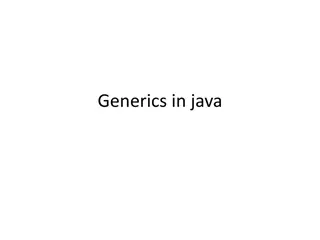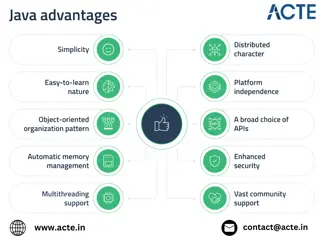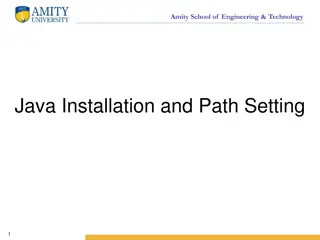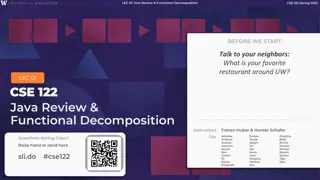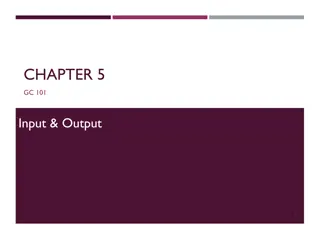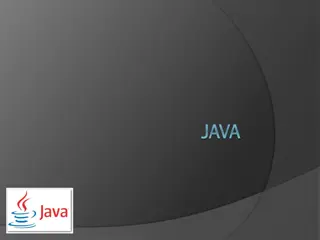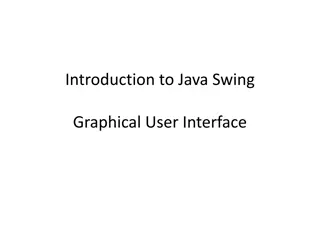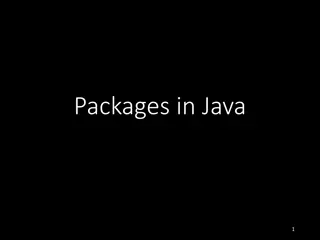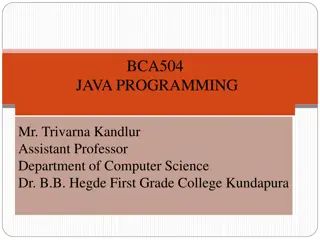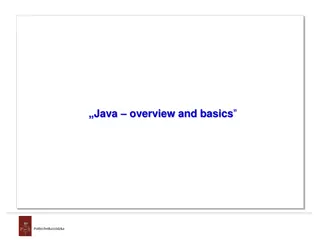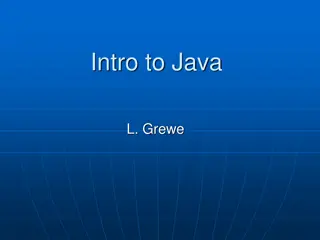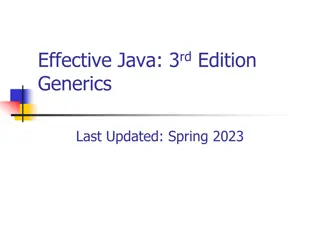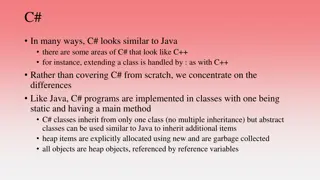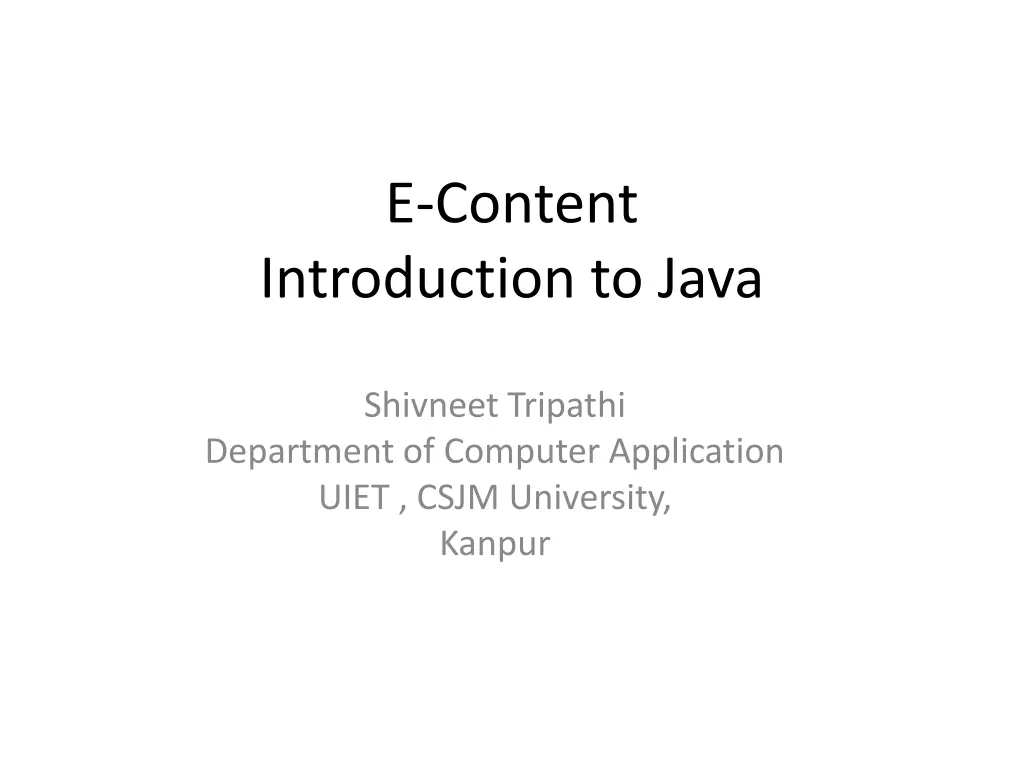
Introduction to Java: Features, Object-Oriented Programming, and Security
Explore the origins and powerful features of Java, including its object-oriented nature, simplicity, robustness, security, and distributed capabilities. Learn about key concepts such as abstraction, encapsulation, inheritance, and polymorphism that define Java as a simple, robust, secure, and distributed language for modern programming needs.
Download Presentation

Please find below an Image/Link to download the presentation.
The content on the website is provided AS IS for your information and personal use only. It may not be sold, licensed, or shared on other websites without obtaining consent from the author. If you encounter any issues during the download, it is possible that the publisher has removed the file from their server.
You are allowed to download the files provided on this website for personal or commercial use, subject to the condition that they are used lawfully. All files are the property of their respective owners.
The content on the website is provided AS IS for your information and personal use only. It may not be sold, licensed, or shared on other websites without obtaining consent from the author.
E N D
Presentation Transcript
E-Content Introduction to Java Shivneet Tripathi Department of Computer Application UIET , CSJM University, Kanpur
Introduction to Java JAVA was originated at Sun Microsystems Inc., in 1991. It was conceived by James Gosling and Patrick Naughton. Simple programming language to write, compile and debug a program easily. Helps to create modular programs and reusable code.
Powerful Features Java has the following features Object Oriented Simplicity Robust Platform Independent (Portable) Security Distributed Applications Multithreading
Object Oriented Programming Abstraction Denotes the extraction of essential characteristics of an object that distinguish from all other kinds of objects. Encapsulation Hiding the implementation details of a class. Forces the user to use an interface to access the data. Inheritance Process by which one class acquires the properties and functionalities of the other. Polymorphism Means the ability of methods to exist in several different forms
Java is a Simple Language Does not have complex features as other programming languages like Operator overloading, Multiple inheritance through classes, pointers and Explicit memory allocation.
Java is a Robust Language Two main hurdles which cause program failures i.e memory management mistakes and mishandled runtime errors can be overcome. Memory management mistakes can be overcome by garbage collection. Garbage collection is automatic de- allocation of objects which are no longer needed. Mishandled runtime errors are resolved by Exception Handling procedures.
Java is Secure Provides a virtual firewall between the application and the computer. Java codes are confined within Java Runtime Environment (JRE).
Java is Distributed Java is designed for the distributed environment of the internet. Objects on one JVM can execute procedures on a remote JVM.
Multithreading Enables a program to perform several tasks simultaneously.
Java is Platform Independent An application developed on Java can run in any machine. When Java is compiled, it is not compiled into platform specific machine or platform independent byte code. The byte code is distributed over the web and interpreted by Java Virtual Machine (JVM) on whichever platform it is run.
Java Virtual Machine(JVM) JVM acts as an interpreter and converts byte codes to machine codes. The source code of Java is stored with .java extension and the compiler ie., javac converts .java code into byte code. Byte codes are Binary Language codes and will be in a file with extension .class . The byte codes are interpreted by JVM and .class file that is generated is the machine code of the processor. JVM is platform dependent. The JVM must be implemented on a particular platform before compiled programs can run on that platform.
Setting the PATH The PATH variable is used to locate the executable files by the operating system. Windows: Set PATH=%PATH%; %JAVA_HOME%\bin UNIX: Set PATH=$PATH: $JAVA_HOME/bin
Compilation and Execution of Java Program To create a java code an editor such as notepad, text pad or an IDE like eclipse can be used. Sample Java Program: public class WelcomeApp { public static void main(String[] args){ System.out.println( Welcome to Java ); }//End of main }//End of WelcomeApp Class Output : Welcome to Java
In the above program the class WelcomeApp has public access and hence declared public. class is the keyword used to create a class. For running stand alone programs main method is needed which has a signature similar to the one defined in the above program. Main method takes an array of strings as an argument. The name of the array can be anything. To display the output, pass the string as an argument to the method system.out.println
Compiling and Executing a Java Program Step1: Save the source file as WelcomeApp.java Step2: Open command prompt and navigate to the directory where you have stored the file. Step 3: To compile, type javac WelcomeApp.java and press Enter. Step 4: On successful compilation, you will see the command prompt and WelcomeApp.class file in the same folder where WelcomeApp.java is stored. This is the byte code of the program. Step 5: To execute, type java WelcomeApp. Do not type the extension while executing. Step 6: See the output Welcome to Java displayed on the console.
Common Programming Errors in Java The following are the general programming errors and the solution for them while running on windows machine. javac is not recognized as an internal or external command, operable program or batch file This means that the operating system cannot find the compiler - javac. In order to resolve this the PATH variable has to be set. Exception in thread main java.lang.NoClassDefFoundError: WelcomeApp This error means that java cannot find your compiled byte code, WelcomeApp.class. If the class file is present in directory other than the directory where java file is stored, then the CLASSPATH must be set pointing to the directory that contain compiled class files.


